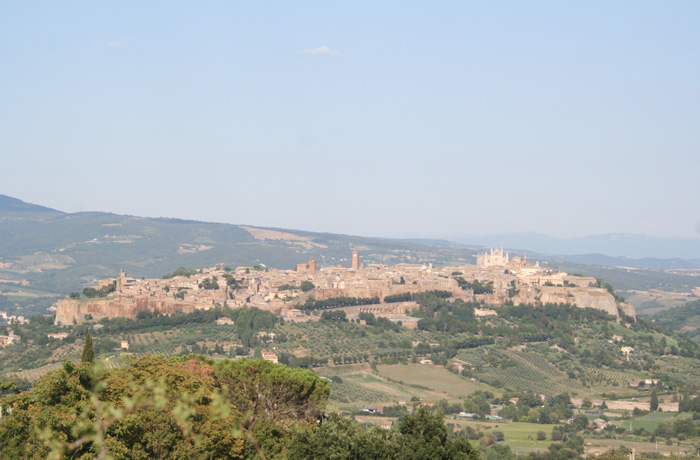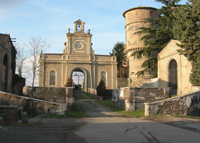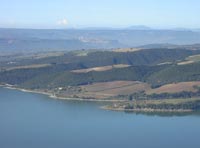| |
|
| Located on a plateau of volcanic tuff, the impressive city of Orvieto is surrounded by a stupendous landscape of fields and vineyards; the unbreachable walls appear to encircle the city rather than elevate it, as though it were a fortress rising on the flat valley floor of the river Paglia.
Orvieto still preserves its charming Medieval character, thanks to its location, to its Etruscan roots and to its celebrated Cathedral.
Orvieto, in the southern end of the Umbria region of central Italy, is situated on a tuff cliff with overhanging walls, which dominates the plain below.
Orvieto flourished in the Middle Ages when it became a powerful Comune. The majestic monuments of this period include the Palazzo del Capitano del Popolo, the Torre del Moro and the Torre di Maurizio, at one corner of Piazza del Duomo. But Orvieto is known above all for its Duomo (Cathedral), this incredible example of Italian Gothic architecture. The cathedral houses many works of art, with pride of place going to the San Brizio chapel and Luca Signorelli's frescoes of the End of the World (1499-1504). The figurative opulence (J.Riess) of the Cappella Nuova is one of the best known masterpieces of Renaissance Italian art. The chapel was built between 1406 and 1425 over the 14th century structure that supported the transept and opens onto the southern part of the cross nave, formerly occupied by the sacristy and the semi-circular Monaldeschi chapel, symmetrically aligned with the SS Corporale chapel. Beato Angelico and Luca Signorelli worked on the decorations of the entire chapel.
On the same square as the Cathedral the Faina and Soliano Palaces are situated, both seat of prestigious museums. On the right side of the cathedral there is a small square, which is located on the papal and Episcopal palace complex, known as the Papal Palace, where there is the National Archaeological Museum.
The northwest area of Orvieto, runs between houses, medieval towers, and ancient Etruscan walls, shady courtyards and palaces with elegant mullioned windows, which offer a panoramic view over the valley of the Paglia River. At the end of Via Malabranca note the Church of St Juvenal, with a linear front and an interior almost completely covered with frescoes by local painters, between the thirteenth and sixteenth century.
The Republic Square opens at the point where the Roman Forum was situated. On the south side of the square stands the Town Hall, built in the early thirteenth century, and then continued in the sixteenth century. On the east side of the square stands the Church of St. Andrew , built between the eleventh and twelfth centuries on the ruins of a pre-existing paleo-Christian building; the left side is enriched by a colonnade and the three naves, marked by granite columns. On the right, note the solemn bell tower decorated with mullioned windows. In this elegant and lively area of Orvieto, there are many antique shops.
Continuing, we reach the tree-lined 'Piazza XXIX Marzo' and the Church of San Domenico, with a Gothic portal, and the lunette frescoed in the early fifteenth century. Also on the same square is the former Dominican Convent, famous for being the seat of Tribunal of the Inquisition.
In the eastern sector of the city there is the 'Pozzo di San Patrizio', built and designed by Antonio Sangallo the Younger (1484-1546) at the behest of Pope Clement VII (1478-1534), in order to avert water shortages in the event of prolonged siege; it is cylindrical structure and it is surrounded by two overlapping spiral staircases. Near the well are the mighty castle, built by Cardinal Albornoz (1310-1367) and the evocative remains of the Etruscan Temple of Belvedere, dating from the fifth century BC and rediscovered in the early nineteenth century.
Leaving "Porta Romana", outside the city, there is the Abbey of St. Severus and Martyrdom, a former Benedictine complex, built in the sixth century. The Abbey includes different environments, including the Old Church, preceded by a spectacular arch, dating from the thirteenth century, and rich in a valuable paving of Cosmatesque style. |
|
|
|
| |
|
Umbria is a land-locked region in the heart of central Italy, between Tuscany to the west and Le Le Marche to the east.
The capital of the region, Perugia, is centrally placed, and the ancient city of Spoleto is well located for exploring the southern part of Umbria.To the north-west of the region, Lake Trasimeno (and the village of Castiglione del Lago) is an attractive destination
The axis that passes down through the centre of Umbria from Perugia to Spoleto via Assisi passes the ancient town of Foligno and some attractive villages en-route, including Gubbio to the north and Spello and Montefalco further south. Trevi and Bevagna should also be high on your list of attractive villages in this region.
Head to the east for the fine mountain scenery of Monti Sibillini, being sure to stop off to explore Norcia on the way. The scenery of the Valnerina region is equally enticing - more rolling than mountainous, and very worthy of being explored.
With the ethereal landscapes, seen in so many paintings, medieval hill towns, beautiful frescoes, good wine and olive oil, and the gentle natural rhythm of the seasons Umbria has always been a source of inspiration and a place for pilgrimage, artistic and spiritual. St Benedict and St Francis, both founders of monastic orders, were born in Umbria. St Francis is associated not only with Assisi but with the great monasteries of Camaldoli and La Verna, where he received the stigmata.
Perugia is the capital of Umbria and a major centre of Italian art and architecture. The Cathedral of S. Lorenzo stands on the Piazza IV Novembre which is also the location of the splendid Fontana Maggiore. Another side of the piazza is formed by Palazzo dei Priori (the Town Hall, encompassing the Collegio del Cambio, Collegio della Mercanzia, and Galleria Nazionale). The Collegio del Cambio has frescoes by Pietro Perugino, while the Collegio della Mercanzia has a fine later 14 C wooden interior. Other major sights are the Church of San Pietro and the Tempio di San Michele Arcangelo, a round church built on the foundations of a Roman temple.
Lake Trasimeno, known historically as "the lake of Perugia", is the largest lake in peninsular Italy, being slightly smaller than Lake Como. The lake has three islands, one inhabited, and several attractive villages on its circumference. Passignano, Monte del Lago and Castiglione del Lago have all remained virtually intact through the centuries. The shores of Lake Trasimeno are for the most part dense with reeds that are the home to a wide range of bird-life. A drive around the lake makes an excellent one day excursion.
Tuscany | Lake Trasimeno Lago | Lake di Trasimeno
Assisi, at the foot of Mount Subasio, conserves masterpieces, not only valuable and beautiful but also mystically evocative. Another place of interest in the Tiber Valley is Città di Castello, with the beautiful 14th century churches of St. Dominic and St. Francis and the Gothic Town Hall. Gubbio, to the east is a small ancient Umbrian town that has conserved its medieval appearance and outstanding monuments. To the south, near the Marches border, lie Gualdo Tadino, Nocera Umbra, and Foligno with its 12th century Duomo with a Romanesque façade. Nearby is Spello, an ancient Roman centre where you will find the 13th century church of St. Maria Maggiore with famous frescoes by Pinturicchio.
Heading towards Terni, Montefalco sits in a splendid panoramic position, with interesting religious buildings. Further south lies Trevi and the idyllic surroundings of the Springs of Clitunno and the little early Christian church nearby. Still further south lies Spoleto, the ancient capital of the Lombard Duchy, rich in works of art, and famous for the Festival of the Two Worlds with its splendid theatrical productions, concerts and artistic events. Turning west is Todi, with its fine main square flanked by medieval buildings. Todi was important to both Etruscans and Romans and is the location of several interesting Gothic and renaissance buildings, including the 11 C cathedral and 13 C palazzi. Its triple walls are still easily discerned. The innermost is Etruscan, the middle wall is Roman, and the outside wall dates from the 6 C or 7 C. Todi's most striking church is the domed Renaissance Church of Santa Maria della Consolazione beautifully located just outside the city walls.

|
| |
|
|
|
|
|
| |
|
|
|
|
|
|
|
|
|
Castel Viscardo |
|
Orvieto, Duomo |
|
Lago Corbara and Orvieto |
| |
|
|
|
|
| |
|
|
|
|
Orvieto DOC
Orvieto is an Italian wine region located in Umbria and Lazio, centered around the commune of Orvieto. It is primarily known for its white wines made from a blend of mostly Grechetto and Trebbiano, which is sold under the Denominazione di origine controllata (DOC) Orvieto and Orvieto Classico. Blended red wine and eight varietal reds are sold under the Rosso Orvietano DOC. The region has been producing wine since the Middle Ages, when Orvieto wine was known as a sweet, golden yellow wine. Today's white Orvieto is dry, but a semi-sweet style, known as Orvieto Abboccato, and dolce (sweet), are also produced in small quantities.[1]
Geography
The Orvieto zone is located in the southwest corner of Umbria, centered on the commune of Orvieto in the province of Terni. It extends southward into the Viterbo province of Lazio and north to the border between Terni and the province of Perugia. The Orvieto Classico region is located around Orvieto in the area dominant by tufa limestone and volcanic soil.[1]
History
Viticulture was introduced to the Orvieto region by the early Etruscans, who carved out cellar-like caves from volcanic soil that could house wine production with long, cool fermentation and produced the type of sweet wine that was popular in the ancient world.[2] From the Middle Ages to the mid-20th century, the Orvieto region was known for the sweet dessert wine made with the noble rot, Botrytis cinerea. Unlike most botrytized wine, such as Sauternes, where the grapes are introduced to the Botrytis cinerea fungus while they are on the vine, the grapes of Orvieto were exposed to the fungus after harvest, when they packed into crates and barrels and stored in humid grottoes carved out of the tufa stone. Made primarily from the Trebbiano sub-variety Procanico, which produces smaller berries than the Trebbiano used in Tuscan wines, these sweet wines were deep gold in color, described by the poet Gabriele d'Annunzio as "the sun of Italy in a bottle".[3] While the production of fully botrytized wine is rare, in ideal vintage years some producers will make a sweet muffato from partially botrytized grapes.[2]
Wine
White Orvieto is composed primarily of Grechetto and Trebbiano and a blend of Malvasia, Drupeggio, Verdello and Canaiolo Bianco grapes.[3] Grechetto is valued for the fruitiness and weight that it brings to the wine; some of the most highly rated examples of Orvieto have a high concentration of Grechetto.[1] The wine today is radically different from the historical sweet Orvieto, with off-dry and sweet wines accounting for less than five percent of total production. In addition to the traditional grape varieties listed, some Orvieto producers have begun experimenting with non-DOC Vino da Tavola wines made from Riesling and Sauvignon blanc.[3]
Rosso Orvietano
The Rosso Orvietano DOC covers the entire Orvieto zone and is used for the blended red wines made from Aleatico, Barbera, Cabernet Franc, Cabernet Sauvignon, Canaiolo, Cesanese, Ciliegiolo, Colorino, Dolcetto, Merlot, Montepulciano, Pinot Nero and Sangiovese. Red varietal wines are also permitted under their DOC as long as they contain at least 70% of Aleatico, Cabernet Franc, Cabernet Sauvignon, Canaiolo, Ciliegiolo, Merlot, Pinot Nero and Sangiovese.[1] The advent of the Indicazione Geografica Tipica (IGT) classification has given Orvieto producers the ability to experimented with non-DOC wines and sell them under one of Umbria's IGT classifications.[3]
References
[1] M. Ewing-Mulligan & E. McCarthy Italian Wines for Dummies pg 177-179 Hungry Minds 2001 ISBN 0764553550
[2] H. Johnson and J. Robinson The World Atlas of Wine pg 181 Mitchell Beazley Publishing 2005 ISBN 1840003324
[3] J. Robinson (ed) "The Oxford Companion to Wine" Third Edition p. 500 Oxford University Press 2006 ISBN 0198609906
Tuscany | Wine in Tuscany
|
|
|
|
![]()
![]()






